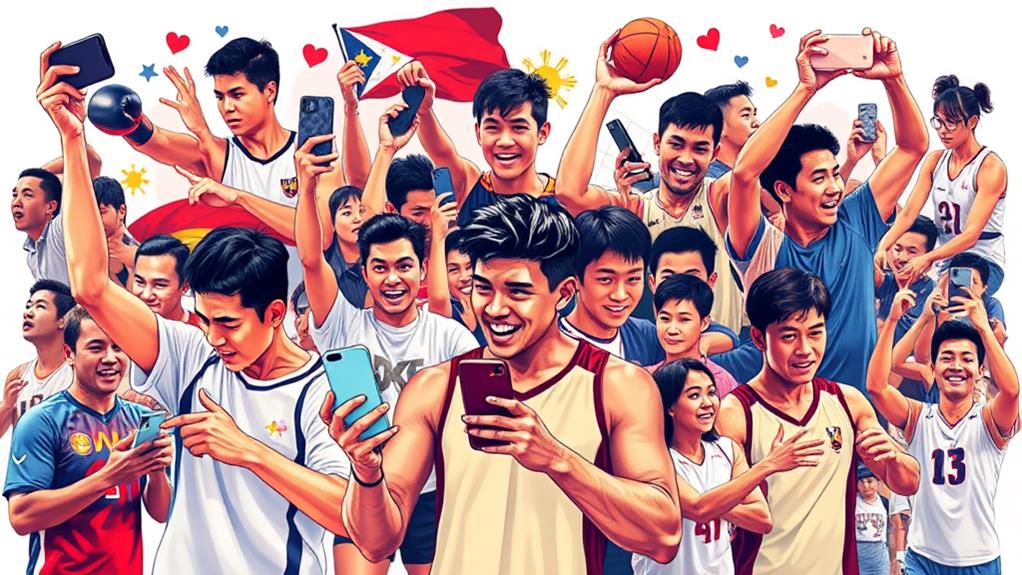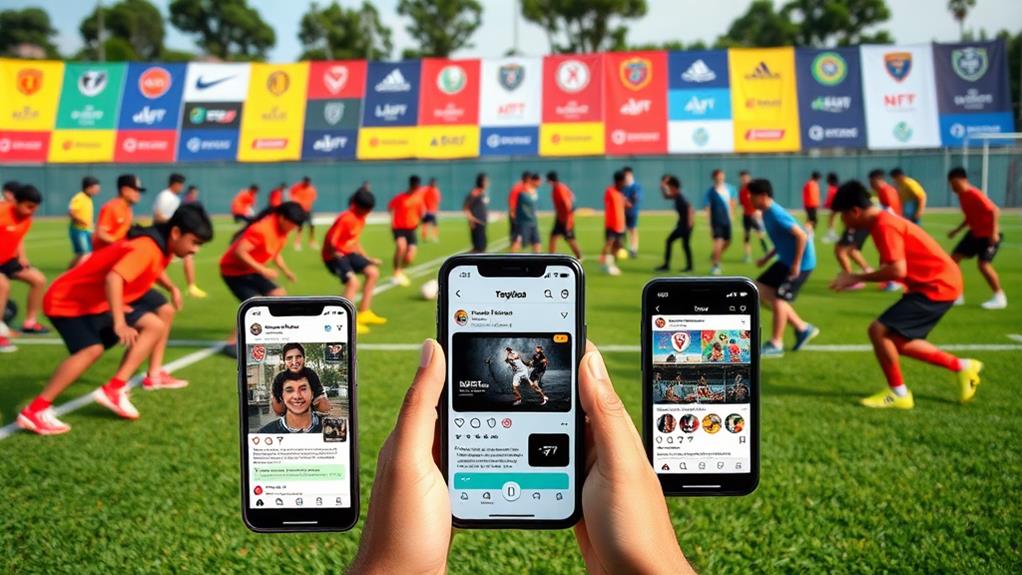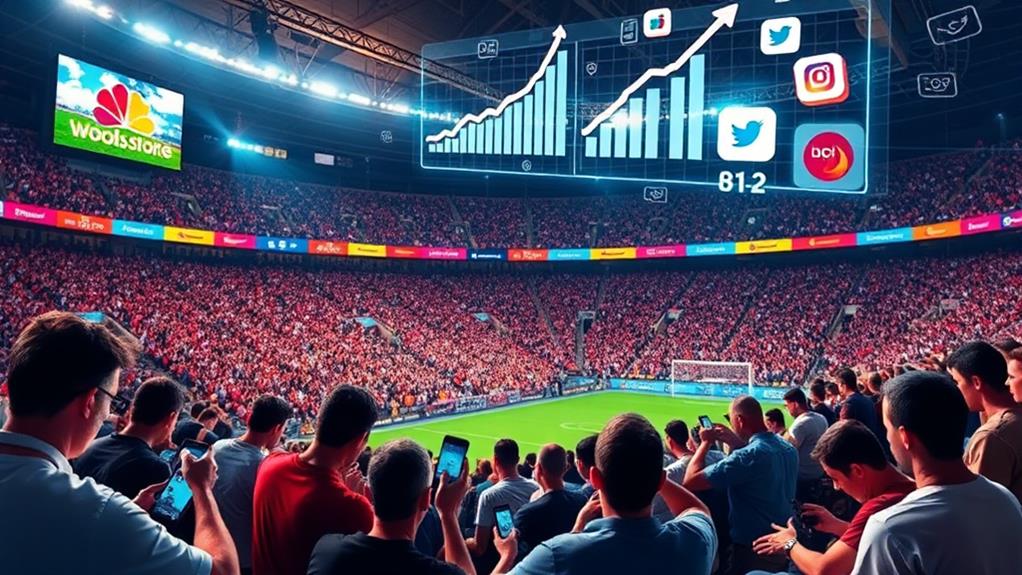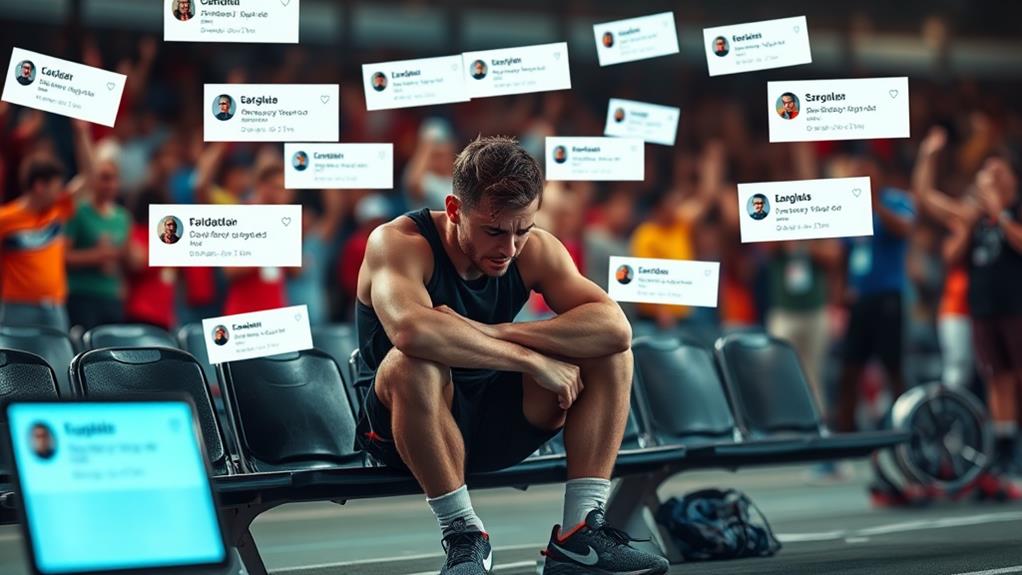Social media has revolutionized the sports landscape in the Philippines by connecting fans directly with athletes and teams, fostering a vibrant community. This connection is made possible by the high percentage of sports fans, 76%, who use social media platforms to stay updated on their favorite sports and teams.
Social media platforms provide real-time updates and highlights, keeping fans engaged and informed about the latest developments in the sports world. Moreover, these platforms promote grassroots initiatives, helping local athletes gain visibility and sponsorships. For instance, social media campaigns can raise awareness about local sports events, attracting sponsors and spectators.
The dynamic interaction between athletes and fans on social media also enhances athlete-fan relationships, allowing for meaningful conversations that influence brand partnerships.
However, negative feedback can affect mental health, and athletes must be aware of this potential challenge.
The impact of social media on sports in the Philippines is profound, and it will be interesting to see how these shifts will continue to reshape the sports landscape and influence the future of sports media and community engagement.
Overview of Social Media Influence

Social Media's Impact on Philippine Sports
97% of internet users in the Philippines engage with social media, significantly altering the sports landscape. This digital interaction enables athletes and fans to connect, forming a community centered around shared interests.
Filipino athletes use social media to build relationships with followers, enhancing their public profiles and fostering a sense of belonging among fans.
Social media is a vital tool for sports organizations. With 76% of sports fans using social media to follow teams and players, organizations can effectively promote local sports events, increasing attendance and viewership.
Real-time updates and engaging highlights keep fans informed, making them feel like active participants in the sports they love.
Grassroots sports promotion has gained momentum through social media. Local athletes and teams leverage social media to gain visibility, attracting sponsorships and support that were previously difficult to secure.
Ultimately, social media profoundly influences engagement in Philippine sports, creating a dynamic interplay between athletes, fans, and organizations, enriching the sporting experience for everyone involved.
Athlete-Fan Communication Dynamics
Social media has transformed the way Filipino athletes interact with their fans, providing a direct line of communication that fosters a sense of community and engagement.
Real-time updates on training and personal insights strengthen fan loyalty. When athletes share behind-the-scenes content, fans feel more connected and invested in their favorite athletes' journeys. For instance, a Filipino boxer might post a video of their intense workout routine, generating excitement and anticipation for their upcoming match.
70% of Filipino sports fans actively follow their favorite athletes on social media, highlighting the significance of these platforms in fan engagement. This staggering figure indicates that fans are eager to stay updated on their idols' lives and careers.
Athletes use social media to address social issues and promote grassroots sports initiatives. By leveraging their influence, athletes can raise awareness about important causes and inspire positive change.
For example, a Filipino basketball player might use their platform to promote a charity basketball tournament, supporting underprivileged youth.
Two-way conversations on social media enhance personal brand building, leading to sponsorship opportunities. When athletes engage with their fans directly, they build a loyal following and increase their marketability.
This, in turn, can attract sponsors seeking to partner with popular and influential athletes.
Social Media's Role in Recruitment

Social Media's Impact on Recruitment in Philippine Sports
Social media has significantly reshaped recruitment in Philippine sports. Athletes with strong online presences are now prioritized by sports organizations, as they attract sponsors and boost visibility. This shift enables athletes to showcase their skills on platforms like Instagram and TikTok, increasing their marketability and translating to endorsement deals and sponsorship opportunities.
Social Media Factors Influencing Recruitment
Online Presence: A strong online presence attracts sponsors and fans. For example, athletes with large followings are more likely to secure sponsorship deals.
Marketability: Social media increases endorsement opportunities for athletes. Brands seek popular athletes to promote their products or services.
Engagement Metrics: Follower counts and interaction rates are critical in identifying potential recruits. A high engagement rate can make an athlete more attractive to sports organizations.
Showcasing Skills: Social media allows athletes to demonstrate their abilities through videos of training or competition. This helps sports organizations assess an athlete's skills and potential.
Connection with Teams: Social media fosters relationships between athletes and scouts. Direct messaging or tagging coaches can lead to recruitment opportunities.
The Result: Social media's role in recruitment is transforming the Philippine sports landscape, aligning it with global trends.
By leveraging social media, athletes can increase their visibility, marketability, and recruitment opportunities.
Impact on Sports Participation
The rise of social media has both positively and negatively impacted sports participation among youth in the Philippines. Increased exposure to sports media correlates positively with youth participation. However, the surge in screen time, especially during the COVID-19 pandemic, has led to a decline in physical activity.
Traditional media, like newspapers and television, show a stronger correlation with youth engagement in sports compared to social media. This is because traditional media often feature in-depth stories and interviews with athletes, inspiring youth to participate in sports.
Sports celebrities featured in media significantly shape youth attitudes, encouraging participation. For example, when a popular basketball player is featured in a commercial or interview, it can motivate young people to start playing basketball.
However, there's a growing trend of youth consuming sports as spectators rather than participants. This affects overall sports participation rates and contributes to a sedentary lifestyle.
Only 27.5% of children meet the WHO's recommended exercise levels, indicating a pressing need for strategies that promote physical activity.
To maintain a healthier lifestyle, it's essential to balance sports consumption with active participation. This can be achieved by setting aside time for physical activity, joining sports teams or clubs, and encouraging friends to do the same.
Revenue Generation Strategies

Sports organizations in the Philippines are leveraging social media to generate revenue. This is evident in the way they use platforms like Facebook and Instagram to promote events and merchandise directly to fans.
For example, the Philippine Basketball Association (PBA) has seen a significant 50% increase in engagement rates among younger audiences, leading to a boost in ticket sales.
Sponsorship deals are shifting towards digital marketing strategies. Brands now prioritize athletes and teams with strong online followings, as visibility on social media platforms translates into lucrative partnerships.
This trend is driven by the growing importance of online presence in the sports industry.
Influencer collaborations are a new revenue stream. Athletes can connect with fans on platforms like TikTok and Instagram, generating income through sponsored content.
This strategy has proven effective, with social media-driven merchandise sales surging by 30% during major sporting events, thanks to targeted ads.
Cultural Considerations in Engagement
Cultural Factors Driving Engagement in Filipino Sports
In the Philippines, social media plays a significant role in enhancing fan interaction in sports, with 97% of Filipinos active on platforms like Facebook and Twitter. These channels connect fans with their favorite athletes and teams, fostering a vibrant online community that thrives during live sports events, especially PBA games.
Community Spirit: The Filipino value of "Bayanihan" encourages collective support for teams and athletes, with fans coming together to cheer for their favorites. For instance, during PBA games, fans unite in their support, creating a sense of camaraderie and shared experience.
Sports Celebrity Influence: Sports icons like Manny Pacquiao and Alyssa Valdez leverage their social media presence to share their stories, inspiring national pride among fans. Their influence extends beyond sports, as they use their platforms to promote social awareness and engage with their followers.
Active Participation: Fans actively share content and engage in online campaigns, fostering deeper connections with athletes and teams. This participation creates a sense of ownership and encourages fans to take an active role in shaping the sports narrative.
Social Awareness: Athletes use their social media platforms to address social issues, resonating with fans and promoting important conversations. By doing so, they raise awareness about critical topics and inspire positive change.
What Role Does Social Media Play in Reporting and Covering Sports Events in the Philippines?
The role of social media in sports journalism in the philippines cannot be understated. With the rise of platforms like Twitter and Facebook, journalists can reach a wider audience in real time, providing instant updates and analysis. It has also opened up new opportunities for citizen journalists to contribute to the coverage of sporting events.
Challenges Faced by Athletes

Social Media Pressure Affects Athletes' Mental Health
Athletes face intense pressure from social media, with 58% reporting that negative comments impact their mental health. This scrutiny often results in anxiety and depression, especially during major sporting events where expectations soar.
Public Expectations Create Stress
About 70% of athletes experience significant stress due to public expectations amplified by social media. The constant demand to meet these standards can overshadow their performances, turning achievements into mere targets for criticism.
For example, during competitions, athletes are bombarded with harsh feedback that distracts them from their focus and performance.
Lack of Content Moderation Exacerbates the Problem
The lack of effective content moderation on social media platforms creates a hostile environment that exacerbates these challenges.
Athletes must navigate a digital landscape fraught with negativity, which affects not only their mental health but also their ability to perform at their best. This issue highlights the urgent need for greater support systems to help athletes manage the pressures of public engagement in an increasingly digital world.
Future Trends in Sports Media
The future of sports media in the Philippines is shifting towards digital platforms. As mobile internet access grows, fans are increasingly engaging with sports content on social media platforms, which has significant implications for sports marketing and fan base expansion, especially among younger audiences.
Social media influencers are creating new marketing opportunities for brands. For instance, brands can partner with popular influencers to promote sports events and products, reaching a wider audience.
Live streaming on platforms like Facebook and YouTube is revolutionizing the way fans experience sports. This allows fans to watch live sports events and interact with other viewers in real-time, creating a more immersive experience.
The esports sector is booming, with a projected value of $1 billion by 2025. Social media plays a crucial role in promoting competitive gaming, with platforms like YouTube and Twitch providing live streams and updates on esports events.
TikTok is increasingly being used for sports content, pushing brands to adapt their marketing strategies. Brands are now creating short, engaging videos to promote sports events and products, catering to TikTok's younger audience.
The future of sports media in the Philippines will rely heavily on new media technologies. As fans turn to social platforms for real-time interaction and updates, there will be a shift in how sports events are marketed and consumed.
Embracing these changes is essential for brands looking to connect with a passionate and engaged fan base.
Questions and Answers
What Is the Impact of Social Media on Sports?
Social media significantly enhances fan engagement in sports by providing a platform for real-time discussions and debates.
For instance, viral moments like stunning goals or incredible catches spark conversations and create a buzz around the sports world.
Athletes utilize social media to build their personal brand, showcasing their skills, personalities, and interests.
This increased visibility opens up new sponsorship opportunities, allowing athletes to partner with brands that align with their values and image.
Social media also promotes grassroots sports initiatives, providing a platform for local talents to gain recognition.
Through online interactions, fans become an integral part of a global sports culture that thrives on connection and shared experiences.
What Is the Impact of Social Media in the Philippines?
Social media has a profound impact on the Philippines, significantly influencing social trends and fan engagement. Athletes use social media platforms to build their personal brand, creating new sponsorship opportunities.
For instance, Filipino boxer Manny Pacquiao has millions of followers on Twitter, allowing him to promote his brand and secure endorsement deals.
Online discussions foster a sense of community around shared interests. Fans actively participate in online forums, creating a buzz around local sports events.
Viral campaigns draw attention to local leagues, increasing their visibility and reach. For example, the Philippine Basketball Association (PBA) has leveraged social media to promote its games, resulting in increased attendance and viewership.
Social media amplifies the visibility and reach of Filipino sports culture, making it more accessible to a global audience.
This increased visibility has contributed to the growth of Filipino sports, allowing athletes to gain international recognition and compete at the global level.
What Are the Sports Related Issues in the Philippines?
Athlete Representation and Sponsorship Challenges
In the Philippines, athlete representation and sponsorship are significant issues.
For instance, many athletes struggle to find sponsors to support their training and competitions, hindering their ability to excel in their respective sports.
Inadequate Infrastructure Development
Youth participation in sports is low due to inadequate infrastructure development.
Many schools lack quality sports facilities, limiting access to spaces where young people can engage in physical activities and develop their athletic skills.
Need for Policy Advocacy and Grassroots Initiatives
Policy advocacy is crucial to address these gaps, as it can lead to the allocation of more resources for sports development.
Additionally, grassroots initiatives can spark local interest in sports, encouraging more young people to participate and potentially discover their athletic talents.
Consequences of Inaction
If these issues aren't addressed, the potential of young athletes may remain underutilized, ultimately stunting the country's overall sports development and success.
What Is the Impact That All Forms of Media Have on Sports?
Media significantly influences sports today. One way it does this is by driving fan engagement through content creation, making sports more accessible to a wider audience.
For example, athletes use digital marketing to enhance their personal branding, reaching their audience directly and building a loyal following. This, in turn, opens up new sponsorship opportunities as brands recognize the value of connecting with passionate fans.
The interplay of various media forms can boost participation and viewership in sports.